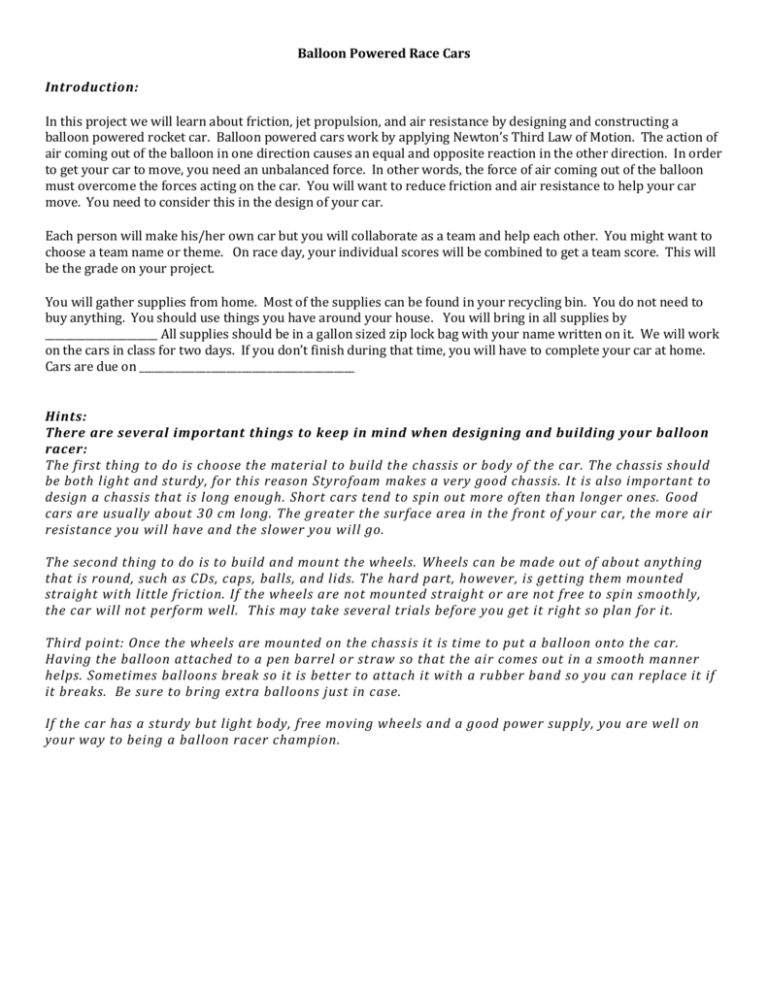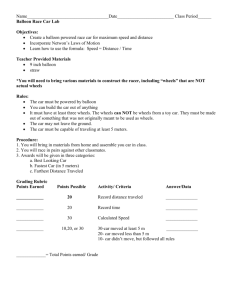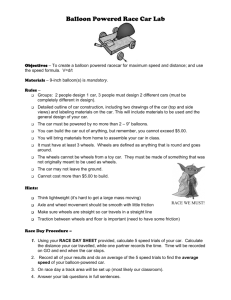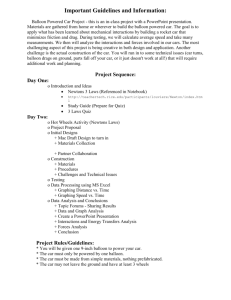Balloon Powered Race Cars
advertisement

Balloon Powered Race Cars Introduction: In this project we will learn about friction, jet propulsion, and air resistance by designing and constructing a balloon powered rocket car. Balloon powered cars work by applying Newton’s Third Law of Motion. The action of air coming out of the balloon in one direction causes an equal and opposite reaction in the other direction. In order to get your car to move, you need an unbalanced force. In other words, the force of air coming out of the balloon must overcome the forces acting on the car. You will want to reduce friction and air resistance to help your car move. You need to consider this in the design of your car. Each person will make his/her own car but you will collaborate as a team and help each other. You might want to choose a team name or theme. On race day, your individual scores will be combined to get a team score. This will be the grade on your project. You will gather supplies from home. Most of the supplies can be found in your recycling bin. You do not need to buy anything. You should use things you have around your house. You will bring in all supplies by ______________________ All supplies should be in a gallon sized zip lock bag with your name written on it. We will work on the cars in class for two days. If you don’t finish during that time, you will have to complete your car at home. Cars are due on __________________________________________ Hints: There are several important things to keep in mind when designing and building your balloon racer: The first thing to do is choose the material to build the chassis or body of the car. The chassis should be both light and sturdy, for this reason Styrofoam makes a very good chassis. It is also important to design a chassis that is long enough. Short cars tend to spin out more often than longer ones. Good cars are usually about 30 cm long. The greater the surface area in the front of your car, the more air resistance you will have and the slower you will go. The second thing to do is to build and mount the wheels. Wheels can be made out of about anything that is round, such as CDs, caps, balls, and lids. The hard part, however, is getting them mounted straight with little friction. If the wheels are not mounted straight or are not free to spin smoothly, the car will not perform well. This may take several trials before you get it right so plan for it. Third point: Once the wheels are mounted on the chass is it is time to put a balloon onto the car. Having the balloon attached to a pen barrel or straw so that the air comes out in a smooth manner helps. Sometimes balloons break so it is better to attach it with a rubber band so you can replace it if it breaks. Be sure to bring extra balloons just in case. If the car has a sturdy but light body, free moving wheels and a good power supply, you are well on your way to being a balloon racer champion. Name _________________________________________ Date __________________ Class _____________________ #____ Balloon Car Rubric Car Name Circle your best trial. Round to the nearest tenth. Trial 1 Trial 2 Trial 3 Trial 4 Distance travels Time Speed Grading Rubric Distance Traveled (0-8) Speed (1-4) Round to the nearest tenth 1- 0-.5 2- .6-1 3- 1.1-1.5 4- 1.6-2 Followed all the rules (0-4) The wheels CANNOT be wheels from a toy car. They must be made out of something that was not originally meant to be used as wheels. Use recycled material or stuff you have around the house. You can attach no more than two balloons. Your name must be clearly written on the bottom of your car. Appearance (0-5) Car Name Clearly Written Includes decoration Includes car name and student name on bottom Sturdy Attention to detail Evidence of design features (0-4) Friction Aerodynamics Mass Size Meet the deadline (1) Total Parent signature _______________________________________________________________







